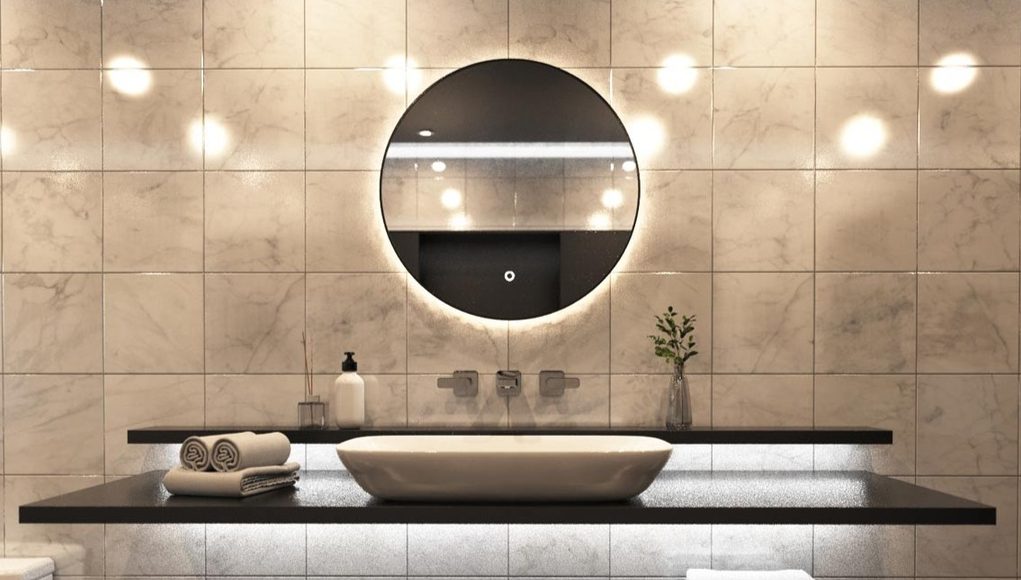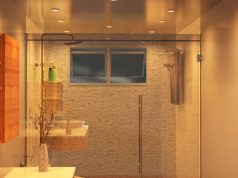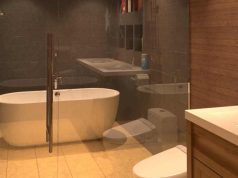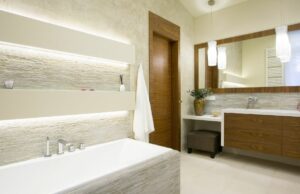Your bathroom is basically a sauna with tiles. Steam clouds, dripping taps, and accidental splash zones will all conspire against your lighting.
That’s why not every light fitting belongs in there. Pop in the wrong one, and you’ll have more than a blown bulb to worry about.
This is where IP ratings step in! They’ll tell you how resistant a light is to dust and, more importantly, water.
Crack the code once, and choosing the right bathroom light stops feeling like you’re deciphering a spy manual.
What IP Ratings Mean and Why They Matter in Bathrooms
IP stands for Ingress Protection. It basically tells you how well a light keeps unwanted visitors like dust and water out of its guts.
Bathrooms are basically obstacle courses for electrical fittings. Water splashes out of sinks and tubs like it’s got something to prove. Steam rolls in from hot showers. Condensation even gathers on surfaces, waiting for a chance to cause trouble.
When water gets into a light, the results are rarely good. Sometimes the bulb just dies an early death. Other times, you’re dealing with shorts, sparks, or a rather shocking wake-up call.
That’s why choosing the right IP rating matters. It’s like armour for your light. Take an IP65 shower downlight, for example. It’s so well sealed that it can handle direct jets of water. That’s the kind of protection you want hovering above your head while you’re shampooing.
The right rating isn’t about overkill. It’s about keeping you safe and keeping your lights working for years, not months.
Breaking Down the IP Rating Code (IP44, IP65, etc.)
At first glance, the IP ratings look intimidating. But they’re really just two digits, nothing mystical and no secret electrician handshake involved.
- The first digit is for solids. Basically, how good your light is at keeping out dust and debris.
- The second digit is for liquids. This shows how resistant it is to water, from light drips to full submersion.
Here’s a handy breakdown you can actually remember:
- IP44. Protected from splashes in any direction. Perfect for general bathroom zones.
- IP65. Dust-tight and resistant to strong water jets. Great above showers or baths.
- IP67. Dust-tight and safe against temporary immersion. Perfect if water is likely to hang around.
Think of it like a superhero ranking system. IP44 is a solid defender. IP65 is a full-blown action hero. And IP67 is your underwater specialist.
Once you know the numbers, shopping for bathroom downlights becomes much easier. Instead of guessing, you’ll know exactly which fitting is built for the job.
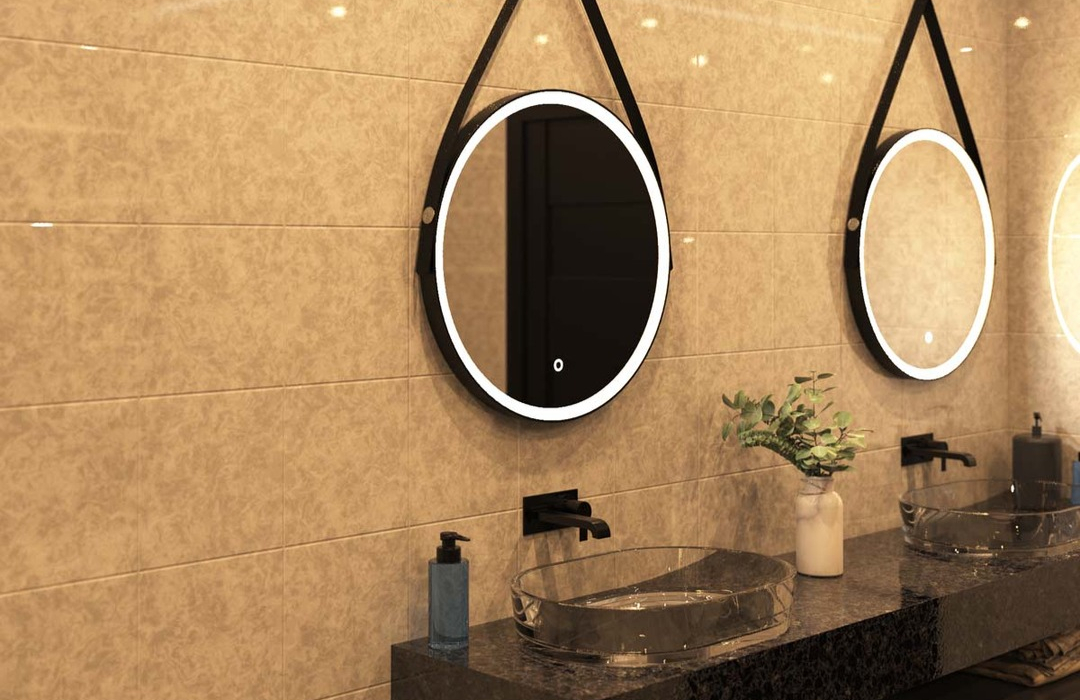
How Moisture and Steam Affect Lighting Safety
Moisture is sneaky. It doesn’t care that you spent ages picking out the perfect fixture. It will still find a way to creep inside if the fitting isn’t sealed.
Bathrooms are full of it. Hot showers turn the room into a foggy jungle. Sinks splash like toddlers at swimming lessons. Even flushing a loo adds humidity into the mix.
All that moisture can collect inside a light. And electricity plus water is not the kind of chemistry you want.
A non-rated light in a damp bathroom won’t just fail early; it could also become dangerous. Overheating, corrosion, and electrical faults are common. In some cases, the damage is invisible until it’s too late.
Sealed, bathroom-appropriate fittings act like little fortresses. They keep moisture out, protect the internal wiring, and ensure the only sparks you see are from your romantic candles.
Common IP Ratings Used in Bathrooms and What They Cover
Different parts of your bathroom face different levels of risk. A ceiling light over the doorway isn’t under the same attack as a downlight directly above the shower.
Here’s how the most common IP ratings stack up:
- IP44 is splash resistant. This is the bare minimum for bathroom fittings and works well for general zones away from heavy moisture. Think vanity lights or wall sconces away from showers.
- IP65 is sealed against dust and protected from water jets. Ideal for Zone 1, directly above baths and showers where splashes are relentless.
- IP67 is designed to handle immersion in water. While you’re probably not planning to dunk your lights, it’s essential in areas at the highest risk of water exposure.
The rule is simple: the closer a fitting is to water, the higher the rating it needs. Ignore that, and you might end up shopping for replacements sooner than you’d like.
Choosing the Right IP Rating for Each Bathroom Zone
Bathrooms are split into zones, each with its own rules for lighting safety. The closer you get to water, the tougher the IP rating needs to be.
In the sections below, we’ll break down each zone—0, 1, 2, and outside—and explain which lights belong where.
Understanding Bathroom Lighting Zones (0, 1, 2, and Outside Zones)
Think of your bathroom as a battlefield, and these zones are the front lines. Each one measures how close a fitting is to water, and how tough it needs to be.
- Zone 0. Inside the bath or shower tray. Needs IP67 at a minimum. These fittings are practically amphibious.
- Zone 1. Above the shower or bath at around 2.25m. As touched upon earlier, IP65 is your go-to here.
- Zone 2. A 0.6m perimeter around baths, showers, or sinks. IP44 is enough for the odd splash.
- Outside Zones. Anything beyond zone 2. Here, IP20 and above work.
Here’s another trick: Whenever you’re unsure, aim higher. No one ever complained that their lights were too safe.
IP Rating Recommendations for Showers, Baths, and Vanity Areas
Now for the practical bit: Which lights go where?
- Showers. Stick with IP65 recessed downlights. They’re sealed, bright, and built to take a soaking.
- Baths. Go with IP65 fittings above the tub. If the design puts them in harm’s way of water jets, IP67 is even better.
- Vanity Areas. IP44 is usually enough here. Wall sconces or illuminated mirror cabinets are perfect, since splashes from sink sessions are inevitable.
- Ceiling Lights Outside the Wet Zones. You can relax a bit. IP20 or IP44 fittings work well for general lighting.
The takeaway? Match the rating to the risk. Your fittings will last longer, look better, and—most importantly—keep you safe.
Light It Right with Simple Lighting
Choosing bathroom lights isn’t just about style. It’s about safety, durability, and keeping water where it belongs: outside your fittings.
By matching the right IP rating to each bathroom zone, you avoid early failures, costly replacements, and the occasional heart-stopping spark. Instead, you get lighting that looks good, lasts longer, and keeps you safe while you enjoy your shower sing-alongs.
At Simple Lighting, we make it easy. Our bathroom lighting range is packed with fittings that tick all the right boxes—stylish designs, proper IP ratings, and quality you can trust.
Stop guessing, start upgrading, and let Simple Lighting brighten up your bathroom the smart (and safe) way.
Find more bathroom lighting insights at Bathroom Lighting Buyers Guide.


